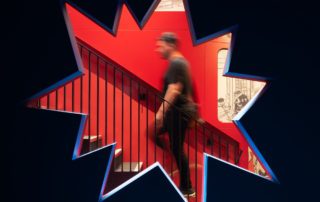Sam Jacob Studio’s Cartoon Museum in London combines playfulness with architectural rigour
Sam Jacob Studio has completed the Cartoon Museum in Fitzrovia, London. Located on Wells Street, the £2m project includes two galleries, a Clore Learning Studio, a shop, offices and archive space. Founded in 2006, The Cartoon Museum was previously sited on Little Russell Street in Bloomsbury, and preserves the best of British cartoons, caricatures, comics and animation.
“The design intention is to turn the graphic world of cartoons into a three-dimensional space that is full of humour and delight”, explains the architect. “Just as in cartoons, physical things don’t behave as one might expect.”
Floor plan and stair axonometrics
From the neon speech bubble sign that announces the museum to the street, a picture gallery red stairwell frames a display of iconic cartoon characters spanning more than a century. The structure is intended to evoke both a staircase hung with portraits in an aristocratic mansion and a cartoon strip.
The museum interior is first glimpsed through a smash-shaped window punched through the wall. A three-dimensional ‘explosion’ marks the visitors arrival, as if the architecture had been subjected to impossible cartoon-like physics.
The shop announces itself with a counter made of giant letters. These greet visitors with a big ‘Hello’, like the text in a cartoon panel. An accessible counter height is formed with a string of smaller exclamation marks, which is intended to evoke the exaggerated world of cartoons. The whole counter sits on an abstracted tiger skin rug. The space is bounded by super-graphic wall treatments that suggest clouds, trees, and even drips, as if it has just been painted into existence.
Doors that sometimes seem too big and at other times too small provide entrances to the gallery spaces. A fake bookcase with a secret door hides the Clore Learning Studio beyond. Behind the playfulness, the design works hard to organise the space, providing both flexible gallery areas and efficiently planned back of house facilities. Inspired by the frames of a cartoon strip, the spatial organisation allows the museum to open up different routes, circuits and spatial narratives in keeping with changing exhibition and programmatic needs.






























